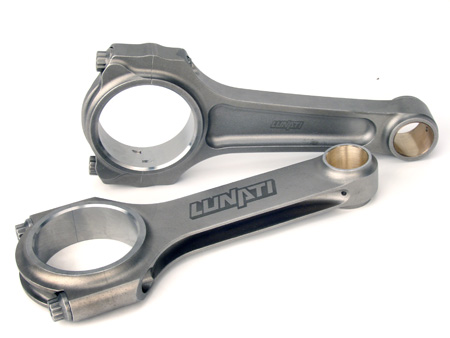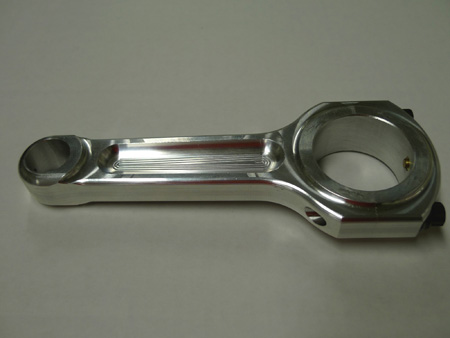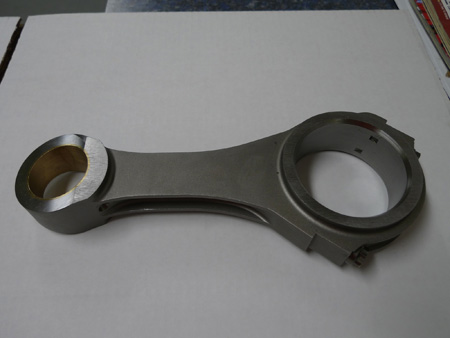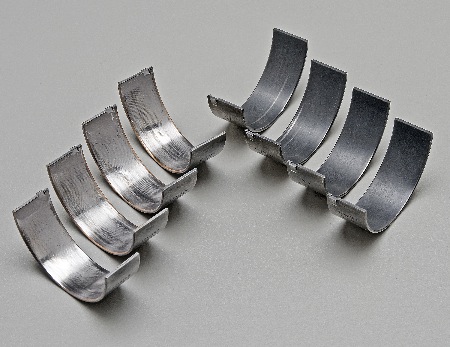Selecting connecting rods and rod bearings for an engine is a lot more complicated when you are modifying the engine from stock specifications. OEMs spend a lot of time and money developing the components that go into a stock engine, and cost is usually a factor in what components are used.
Rod bearings also play a pivotal role and experts say it’s all about the load and how long you have to carry the load that helps determine the type of bearings you should use for each application whether it’s performance, diesel or stock.
As part of the rotating assembly, rods and bearings are an important part of the “character” you are building into your engine. Whether you are reconditioning the connecting rods or installing new, properly prepared and balanced rods, and bearings made of the right materials, will go a long way toward the longevity of your engine and your customer’s happiness with your work.
Connecting Rods
Without a doubt, there are a lot of con rods to choose from, therefore you should have a good idea what your customer wants before you start ordering parts. Stock connecting rods are good enough to handle modest power increases in mild street applications. Building an engine with more than 400-450 hp or one that will rev past 6,000 rpms using stock cast rods is asking for trouble. If you are reaching for big horsepower it is a good idea that you upgrade the connecting rods to a stronger material that can handle the higher loads and pressures of a modified engine.
Engines that produce big power pound down on the connecting rods while engines that rev to higher rpms pull the rods apart. The connecting rods typically don’t bend or break under compression but are pulled apart at high rpm and tend to break during the exhaust stroke. Because of this, performance rods are beefed up for compression strength and stiffness for the higher loads, and the higher tensile strength of the upgraded rods help keep them from snapping apart at high rpms.
In sprint or drag racing applications a lighter connecting rod is usually preferred for quicker acceleration. In these types of engine builds an aluminum rod is often used because of its lighter weight but strength can be an issue. The lighter the rods, the faster the acceleration, but aluminum can stretch over time and needs rebuilt or replaced more often than steel rods.
Proper rod bolt torque is vital to connecting rod life. A rod bolt fastener is without question the highest stressed fastener in the engine. The big end bore of the connecting rod is a stressed bore in much the same way as cylinders are on a block. Experts say it is important to torque properly, preferably with a stretch gauge, to ensure the big end of the rod sizing is correct. Improper torque will most likely lead to rod failure down the road or on the track.
Experts also say to watch for excessively discolored con rods. When the oil film between the crank journal and rod bearing breaks down there is enough heat created to spin the bearings and possibly damage the heat treatment of the rod. There is a lot of debate as to why this happens, but when discoloration is visible (even a very small amount) the rod has been heated enough to compromise or ruin the heat treatment in the steel. This can have unpredictable effects on the strength of the rod. It is a big risk to use these rods again once this has happened. It is best to replace the rod if you are unsure.
There are essentially four types of connecting rods that most engine builders use – cast, forged, billet and powdered metal – in two basic styles: I-Beam and H-Beam. Each type of rod has a purpose and limitations as well. Spending wisely here can save your customer a lot of money but if the rods aren’t up to the task, it will likely lead to you seeing the engine again in the near future.
Cast
Cast rods are often the choice for OEMs because they are inexpensive to manufacture and can handle the loads of a stock engine fairly well. One way for you to distinguish these rods is they have a noticeable seam at the parting line down the middle of the rod where it was poured into a mold. These rods should not be used in high horsepower applications but can handle modest increases up to about 450 hp and 6,000 rpm. Some racing classes mandate that these components remain stock to help control costs and speeds.
Forged
Forged connecting rods are made by a process that forces the grain of the material into the shape of a connecting rod to increase the fatigue life. Some rod manufacturers forge the cap separately so that the grain runs perpendicular to the load forces, which strengthens the connecting rod even more. Many aftermarket connecting rods are manufactured from 4340 steel, which has a certain range of specs that allow manufacturers to choose slightly different materials to achieve the desired results. Some connecting rods are made of a higher amount nickel and chrome that experts say increases the strength and fatigue life without making the connecting rod brittle.
Billet
Billet rods are generally the highest strength connecting rod and mostly used for high end racing builds. These are machined out of one piece of steel or aluminum and come in a variety of styles and material. They are typically CNC machined and stronger, lighter, and more durable than other types of rods. Some billet rods have special design features that reduce stress risers and eases into the natural grain of the billet material. Some rods also include high strength rod bolts for proper clamping load, along with burnished bronze bushings that are honed to the exact pin clearance.
Powdered Metal
Powder metal rods are used by many OEs today because they can be manufactured less expensively than steel rods and they are stronger. PM rods start off as a powdered mix of metal that is pressed into a mold and heated to high temperature, which melts the metal into a solid mass (i.e., sintering). The finished rod is much closer to a finished product and therefore requires very little machining to finish the rod. PM rods have cracked caps, which leaves a unique mating surface and it saves time and additional machining. There are also aftermarket PM rods available for certain applications. PM rods can be a good upgrade over stock cast rods and can handle higher loads, but for big horsepower builds or high rpm applications, high grade steel, aluminum or other exotic materials are usually a better choice.
I-Beam
I-Beam rods are the most common style of connecting rods and are used for most stock applications as well as performance builds. These rods have a large flat area that is perpendicular (90 degrees) to the side beams. The side beams of the rod are parallel to the holes in the ends for the piston pin and crank journal, and provide a good combination of light weight, and tensile and compressive strength. I-Beam rods can handle high rpm tension forces well, but the rod may bend and fail if the compressive forces are too high. To handle big horsepower loads, the I-Beam can be made thicker, wider or be machined in special ways to improve strength.
Rod manufacturers produce a number of variations of the basic I-Beam. Some machine the center to create a scalloped effect between the beams, leaving a rounded area next to both beams that increases strength and rigidity similar to crankshaft fillets. These are sometimes called “oval-beam,” “radial-beam” or “parabolic beam” rods.
H-Beam
H-Beam rods have two large, flat side beams that are perpendicular to the piston pin and crankshaft journal bores. The center area that connects the two sides of the “H” together provide lateral stiffness. This type of design has higher compressive strength and weighs less than an I-Beam rods, say experts. H-Beam connecting rods are often recommended for high torque applications that make a lot of power at below 6,000 rpm. I-Beam rods can also be beefed up to handle most demands but it usually involves increasing the thickness and weight of the rod or using a stronger alloy such as 4340 steel.
Rod Bearings
Bearings, while seemingly simple, are highly engineered to meet specific requirements in relation to the amount of load an engine produces. Experts say you have to look at the type of performance that the engine is intended for before selecting. Is it going to be passenger car, street high performance, competition high performance, heavy duty diesel? Since passenger car engines don’t necessarily operate at wide open throttle, they are not usually fully loaded. However, there are many applications where loading is more severe, such as heavy-duty diesel, marine and performance engines.
One bearing expert explained at Engine Builder’s Bearing Summit held in March that they have seen rod bearings survive in extreme loads such as top fuel drag racing engines where loads can reach 63,000 psi for up to four seconds. He said that bearing longevity is directly related to the amount of load on the bearing. In NASCAR, Formula One and IndyCar loads may exceed 14,000 psi but the average life of those bearings increases to 500 miles or more from a quarter mile. In heavy-duty diesel applications, bearing loads are not as high, around 6,500 psi, but the average lifespan increases substantially to 500,000 miles for these applications.
Bearing experts say the more load you put on a bearing, the more difficult it is to maintain an oil film between the shaft and the bearing. And separate from the level of loading, there are gross loads from combustion and inertia forces that also must be considered.
One of the main things you have to take into consideration is the bearing proportion in comparison to the level of loading. This is where bearing engineers look at unit loading; how many pounds per square inch, not total pounds of load. Not only does bearing proportion determine the level of loading, say experts, it also determines the ability to create a lubricating oil film between the shaft and the bearing. The bearing has to have the proper proportions, and a length-to-diameter ratio of about one-third is pretty much ideal, say experts. With this rule of thumb you can look at a bearing and say that it is probably going to work or if you’ll likely experience some problems with it.
For more information about engine bearings, click on our “Special Issues” section and then click on the Engine Bearing Summit, which contains white papers from the conference held in March.
















